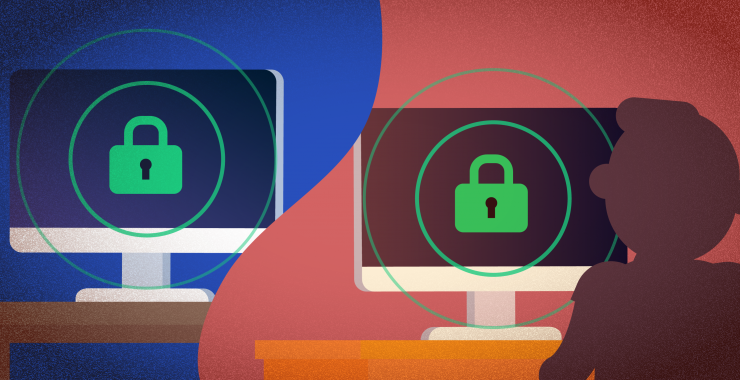As more and more companies are shifting towards remote work, ensuring the security of sensitive data and confidential information has become a top priority. With remote work, there is an increased risk of security breach and cyber-attack. To mitigate these risks, it is essential to implement robust security measures and consider employee training on security best practices.
Although, there are many benefits of using a remote workforce, such as lowering overhead costs and gaining access to a larger talent pool. However, this trend also opens up more opportunities for cybercriminals to hack into your system and stenal sensitive data. Companies should know why digital identity is important and how it can prevent from different types of digital threats.
A cyberattack or security breach can lead to customer loss, brand reputation loss, and productivity/operational loss. In fact, customer attrition rates can increase by as much as 30 percent following a cyberattack or a security breach!
The high cost of cyberattacks is impacting organizations of all sizes, and it’s important to take the right precautions to fence off hackers or any other security breach. This means you need to have a solid incident response plan.
Common security risks for remote teams
Business shifts towards remote work create all-new security challenges. Flexibility and cost-saving benefits from teams distributed across different locations are well-desired point, yet also created more entry points for possible cyber-attacks. Not supported properly, these businesses might open sensitive data, intellectual property, and important systems to cybercriminals.
The shift to remote work expands the attack surface, and as such, it is important for companies to be aware of and address a set of unique vulnerabilities distributed teams face. These vulnerabilities can expose sensitive data, intellectual property, and critical systems to cybercriminals if not properly addressed. Understanding the potential vulnerability assessment cost is crucial in evaluating and mitigating risks effectively.. Failure to secure remote work environments invites data breaches, financial loss, and brand reputation damage. The following are some of the common security risks that remote teams must be aware of:
1. Weak or Stolen Credentials
Weak or stolen passwords rank high among the security threats that remote teams face. Employees mostly reuse passwords across different platforms; thus, once a cyber thief manages to steal credentials, he can easily gain unauthorized access. Passwords serve as one of the main entry points for hackers, and without proper management and protection, they may lead to serious breaches.
2. Phishing Attacks
Among all the hacking techniques leveraged by cybercriminals for access, phishing remains supremely viable. Without a personal form of verification through face-to-face interaction, this threat exists even more so today for work-from-home staff than office workers. By using counterfeit emails, messages, or URLs that look legit, many employees are susceptible to loss of login details, banking information, and malware downloading.
3. Insecure networks and devices
Remote workers connect to the corporate system using personal devices and public Wi-Fi networks, among others, which are highly vulnerable to man-in-the-middle attacks – a situation in which hackers intercept data between the user and the system. In addition, personal devices are not as secure as corporate-issued devices, making them highly vulnerable to malware, ransomware and other malicious software.
4. Poor Endpoint Protection
The computers that many employees use to work, while accessing the systems of their organizations, are mostly on personal devices which aren’t secured properly. Lacking protection such as antivirus for the device or encryption of the device, they easily become exposed to data breach, malware infection, and even ransomware.
5. Uncontrolled access to critical information
One of the risks faced by telecommuting is unbridled access to sensitive information of the organization. The employee working from home or other remote locations may then prefer to store confidential documents in personal computers or in the cloud, which then exposes them to the risk of unauthorized access and inadvertent leaks.
6. Lack of staff training
Human error often plays an important role in security breaches. Without proper knowledge of security risks and best practices, one may fail to not download a malicious attachment or be able to bring to light the evident consistent usage of weak passwords. This leaves the gap in an overall security strategy that bears the “insecurity” tag.
7. Third party vulnerabilities
People who need to work remotely most often use third parties for the entire job. This ranges from using third-party vendors to software-as-a-service companies for project management to utilization of services for communications. Most damaging are the threats caused by third parties that stem from bad vetting and weak security protocols.
With an understanding of the common security risks that threaten remote teams, it’s important to take proactive steps to mitigate these threats, starting with a comprehensive incident response plan.
Best security practices for remote teams
1. Develop an incident response plan
Having a well-defined incident response plan is crucial in the event of a security breach. An incident response plan outlines the steps that employees should take in case of a cyberattack or security breach. The plan should include details such as whom to contact, how to contain the breach, and how to communicate the breach to relevant parties. Ensure that your incident response plan is up-to-date and that your employees are trained on the plan.
For example, the plan should describe the steps employees should take when they lose a device with sensitive data, find out that your infrastructure is accessed by an unauthorized user, recognize unusual account activities, or discover a security vulnerability.
For phishing attempts specifically, training your team on the SLAM method (Sender, Links, Attachments, Message) gives them a simple framework to quickly evaluate suspicious emails before they become security incidents.
You should also have a backup and recovery plan and share it with your distributed team, so they know exactly how to respond during a data leak. This will help you get your system back online as quickly as possible while containing the extent of the breach so that you can minimize costly downtime and unnecessary damages.
2. Enhance endpoint security
When team members use their own equipment to connect to your system remotely, you have to make sure that the devices they use are secure (e.g., computers, smartphones, and tablets).
Make sure you have a comprehensive data security policy, including a BYOD (bring your own device) protocol. To protect data in transit, all connections to your system should be on a secure network and HTTPS platform. Handling email security is a critical part of endpoint management. Encourage employees to use advanced techniques to stop spam emails, whether it’s in Gmail, Yahoo Mail, or Outlook. Implementing robust spam filters can prevent phishing attacks and reduce exposure to potential malicious content.
Emails should be encrypted, and can be protected with a DMARC policy; and remote desktops should be accessed via a Virtual Private Network (VPN). Namecheap, for example, is a highly affordable VPN that has built a good reputation as a safe and reliable option.
Your employees should have endpoint protection software installed on their devices to protect them from data and identity theft. This includes basic antivirus and firewall software, data recovery software, and advanced software that uses machine learning and behavioral analysis to detect suspicious activities or patterns. Consider using virtual desktop infrastructures for easy distribution and cost management. At the end of the day, preventing security breaches is far less costly than curing them if they happen.
3. Enforce password management
Did you know that weak or stolen passwords account for as much as 80% of attacks? Ensuring that your team members are using strong passwords for logging into your system can help lower the chance of attacks.
Each team member should have his or her unique username and password for accessing your network and software platforms. Also, they should not use the same login credential for sites that they use personally.
If you need to share an account and login credentials for specific sites, use a password manager application (e.g., LastPast.) It allows you to generate strong passwords and store them securely so the entire team can have access.
In addition, most software platforms allow you to add 2-factor authentication (also called 2-step verification) to the login process to ensure that a stolen password alone will not result in an account compromise.
4. Set up access control
With remote employees regularly connecting to your network from various locations, the risk of potential breaches is high. So it’s essential to pay attention to remote access security.
Not everyone on your team needs access to all your business data. Many software platforms and document management systems allow users to set up role-based access control. This enables you to give access privilege only to those who need specific information to perform their job functions.
Setting up cyber and physical access control systems, such as turnstile security, can help minimize the amount of data that criminals can steal even if they hack into your system using one of your team member’s credentials.
In addition, many of these applications allow you to track who has viewed, edited, or shared what data and from where so you can identify suspicious activities or unusual patterns that could indicate an attack. For instance, you can take action if you see a user logging in from two different locations at the same time.
5. Provide employee training
Human errors and negligence are the major causes of data breaches so make sure your remote workers knows how to protect themselves and your network from prying eyes.
A comprehensive onboarding process is essential, especially for a remote team, to ensure that every team member understands the importance of following your security policy. You should also provide the right IT support to help them implement the steps, such as configuring their devices and setting up VPN services.
You should also perform employee training on how to prevent cybersecurity threats, such as phishing scams, malware, ransomware, and e-skimming. Build ongoing awareness with regular communications on the latest security best practices so they don’t let their guard down.
In addition, implement a comprehensive offboarding process to handle employee separation. For example, it should include a checklist to help ensure that all access privileges are revoked and former employees no longer have access to your systems, network, or sensitive data.
6. Use secure communication channels
Encourage your employees to use secure communication channels such as encrypted messaging apps or virtual private networks (VPNs) when transmitting sensitive data. Also, make sure that your employees are aware of the risks of using unsecured public Wi-Fi networks and encourage them to use VPNs when accessing sensitive information over public Wi-Fi. Last but not least, think of the website provider ensuring you have secure WordPress hosts.
7. Regularly update and patch systems
Keeping systems up-to-date with the latest security patches and updates is crucial in preventing a security breach. Hackers often exploit vulnerabilities in outdated software to gain unauthorized access to systems. Ensure that your IT team regularly updates and patches all systems, including laptops, servers, and other devices used by remote workers.
Essential security tools for remote teams
Managing remote teams requires the appropriate security tools to protect sensitive data and guarantee secure communications. Let’s take a deeper look at some of the major security tools that should be in place for every workforce working remotely:
- Virtual Private Networks
They will help lock down access to the Internet when accessing corporate systems from remote locations. They encrypt data, mask employees’ IP addresses, and block unauthorized access, especially on public networks. - Endpoint protection software
Antivirus and anti-malware software provides a defense against external threats like ransomware, phishing, and other forms of malware. With multiple personal devices used for work by each employee, endpoint protection is key to security. - Password management solutions
Password managers like Dashlane and Bitwarden provide secure storage and efficient management of credentials. These tools enable the use of complex, unique passwords for each account, greatly reducing the risk of breaches because of weak passwords or reused credentials. - Multi-Factor Authentication
This kind of verification lets users assure themselves by confirming in many different ways. Mixing a password with one more factor-such as phone-based verification, biometric scan-might have significantly reduced the probability of unauthorized access to those applications for remote teams. - Data encryption tools
Encryption software ensures that sensitive data is unreadable without the right decryption key. Encrypting communications, files, and emails means that even if data is intercepted, it remains safe from prying eyes. - Security Information and Event Management (SIEM)
SIEM tools such as LogRhythm or Datadog monitor events on your network and analyze them. It can detect unusual patterns, probably indicating security incidents through logs and system events, enabling rapid response to emerging threats.
Integrating these security tools into your workflow protects against cyber threats and helps lock down business-critical information, allowing organizations to operate with confidence in the digital-first environment.
Final Thoughts
Using a distributed team is a great way to save on operating cost but you need to make sure you’re not cutting corners on IT security. You should invest in setting up the right cybersecurity measures and communicate the security protocols to your team. This ensures that the proper steps are followed so you can protect the safety of your business-critical data.
In conclusion, implementing these 7 security best practices and using security tools can go a long way in safeguarding your company’s sensitive data and confidential information. By developing an incident response plan, enhancing endpoint security, enforcing password management, setting up access control, providing employee training, using secure communication channels and regularly updating and patching systems, you can significantly reduce the risk of a security breach.









Add comment